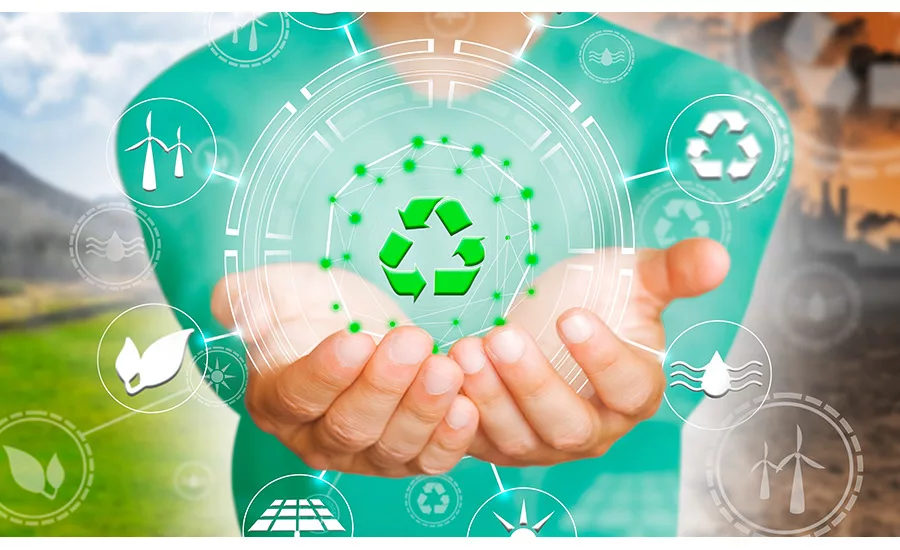Adhesives in Sustainable Consumer Goods
Adhesive manufacturers must support consumer brands as they pursue their sustainability goals.

Image courtesy of H.B. Fuller.
The International Panel on Climate Change (IPCC) released a report in 2018 summarizing the effects of a 1.5°C warming of the planet. The report stated that the Earth is on track to warm 1.5°C by 2040 if we don’t take action.1 The study indicates the planet will experience increased natural disasters and significant and potentially irreversible damage to our societies, economies, and the natural world if the Earth warms to this extent. IPCC states that in order to prevent this warming of the planet, the world must reduce greenhouse gas (GHG) emissions by 50% by 2030 and achieve net-zero emissions by 2050.
Many consumer-packaged goods (CPG) brands are taking seriously their role in combatting climate change by setting aggressive 2025 and 2030 sustainability goals. Company sustainability goals are twofold: reducing manufacturing and shipping GHG emission output, and ensuring goods are packaged and disposed of in a way that causes the least harm possible to the environment.
The Science Based Targets Initiative verifies that companies’ GHG reduction targets are aligned with the IPCC recommendations. To date, more than 1,000 companies are participating in the Science Based Targets Initiative, including many CPG brands and their suppliers (e.g., adhesive manufacturers).2
Guiding Legislation
Europe has been a world sustainability leader. The EU Green Deal, formed in December 2019, sets ambitious targets for the entire continent, ultimately resulting in climate neutrality by 2050. The Green Deal takes a holistic approach to addressing sustainability with the following priorities: clean energy supply, protecting and restoring the natural environment, sustainable use of resources, sustainable transport, transitioning to a circular economy, zero pollution, and sustainable food systems.3
The rest of the world is following suit and putting regulations into place. For example, China is committed to carbon neutrality by 2060.4 Many countries, including France, the Netherlands, and Norway, have announced support to move to electric cars.5 In the U.S., California will ban gasoline-powered cars by 2035. Large vehicle manufacturers, such as Ford Motors and Honda, have publicly supported California’s ban, which is in direct opposition to the automotive industry’s stance two decades ago when many in the industry actively lobbied against electric cars.6 When you combine legislation with corporate commitment, environmental change happens.
CPG Brands and Sustainable Packaging
As science and global legislation guides us toward a sustainable future, many CPG brands are embracing aggressive sustainability goals. For example, P&G is a leading consumer brand that is seeking to be carbon neutral by 2030. Today, 88% of the company’s packaging is composed of recycled materials. P&G created the Pampers Pure brand; unlike many diapers, this line is free of harmful chemicals, fragrances, lotions, and preservatives called parabens and allergens.7 P&G understands that consumers are increasingly concerned about the ingredients going into their products and are willing to pay more for those that are natural and safe.
Apple, one of the world’s most recognized brands, is carbon neutral today. Apple’s goal is to have all its products made from recycled materials and have zero carbon footprint by 2030.8 Some say this is impossible, but Apple embraces the challenge and recognizes that its ambitious goals will shape other companies’ efforts to follow in its footsteps.
In the apparel industry, Patagonia has been a sustainability leader for many years. The company promotes the circular economy through its Worn Wear Platform, which provides used clothing a new life and a new home. Interestingly, Patagonia also has a repair program where employees travel across the U.S. to consumers’ homes to repair their broken items and extend the products’ lifespan. Patagonia is also focused on the circulatory of its products. On average, Patagonia goods are made of 68% recycled material. In addition to offering 100% organically grown cotton, the company strives to do even better by using regenerative organic cotton.9 This type of cotton is grown in soil that scientists have evaluated and determined is healthy, which helps reduce carbon levels in the atmosphere. The certification also takes into account animal welfare and farmworker fairness.
All in all, CPG brands’ focus on sustainability will help our society meet IPCC goals to reduce GHG emissions by 50% by 2030—whether that focus is on using more bio-based or recyclable materials or extending the lifespan of products.
Adhesives and Sustainability
As legislation and consumers demand more sustainable products, CPG brands are beginning to scrutinize (in some cases for the first time) how all their product components, including adhesives, support their sustainability goals. Many CPG brands simply don’t know how their sustainability goals impact their adhesive needs. At this point in time, adhesive manufacturers must support CPG brands in three ways as they pursue their sustainability goals: carbon footprint reduction, circular product design, and supporting the well-being of people.
Carbon Footprint
In the past, CPG brands have focused carbon footprint reduction on internal efficiencies and energy usage (also known as Scope 1 and 2 emissions). Today, CPG brands are moving beyond Scope 1 and 2 and homing in on Scope 3. Scope 3 is defined as reducing GHG emissions throughout a product’s entire value chain—from raw material extraction to post-consumer disposal.
As evidence of this, many customers are beginning to request carbon emissions data on their invoices. Adhesive manufacturers should thus actively measure and report CO2 emissions, and ultimately increase their utilization of lifecycle analysis creation through the ISO 14044 Environmental Management Life Cycle Assessment certification. Adhesive industry suppliers will need to educate their employees on carbon footprint and lifecycle analysis, as well as commit to providing customers with transparent data.
Circular Economy
The term circular economy means that instead of manufacturing products in a linear fashion, brands need to design their products with a waste-out approach. Adhesive manufacturers need to have in-depth knowledge of the circularity of materials, and they need to develop innovative formulas and application processes to support this circularity.
Consumers are guiding the specific circular approach that CPG brands are pursuing—whether that’s creating recyclable goods, reusable goods, or compostable end products. The circular economy may require adhesive manufacturers to use new raw materials that are repulpable or bio-based instead of those that are derived from petroleum. In the electronics industry, adhesive R&D teams may need to develop stronger adhesives to greatly expand the lifespan of finished goods.
Adhesive manufacturers may also need to understand and invest in third-party testing, such as ASTM D6868-19 or D6400 industrial compostability test methods, and Fibre Box Association Voluntary Standard for Repulpability and Recyclability Test Method. Adhesive industry suppliers must explore new materials that may be repulpable, compostable, and/or bio-based.
Well-Being of People
The last area of sustainability involves ensuring that products are safe for consumers. For example, CPG brands must consider the volatile organic compound (VOC) content in their products, as breathing in VOCs is ultimately harmful to the end consumer.
Consumer perception is also very important. For example, one baby-care trend is that mothers want their babies to wear diapers that are free of chemicals and are made from natural substrates such as cotton. In another example of sustainable packaging trends, CPG brands are looking to eliminate polyethylene coatings on packaging—and, indeed, plastic packaging all together. Adhesive manufacturers may be tasked to bond to new materials such as cotton instead of nonwovens, paper instead of plastic, recycled plastic instead of virgin, or uncoated paper instead of coated paper.
Meeting the Challenge
How does the adhesive industry create products that meet end customers’ current sustainability targets—reduce carbon footprint, support circular design, and promise the well-being of people? How do we find ways to measure success without many adhesive industry standards to guide adhesive development and benchmark against? Can the industry come together with CPG brands to create and further define industry standards?
Adhesive manufacturers must be committed to the conversation and to helping achieve a 50% reduction in GHG by 2030 per IPCC guidelines. The industry needs to focus on developing adhesives that help customers create sustainable consumer goods by, for example: extending the durability of electronic goods, helping reduce material usage in disposable diapers, creating paper straws, enabling beer bottles to be efficiently recycled and commercially reused, and reducing packaging material consumption to improve carbon footprint.
For more information, contact the author at (651) 236-5070 or susan.mcnichols@hbfuller.com, or visit www.hbfuller.com.
Footnotes
- “Global Warming of 1.5˚C,” The Intergovernmental Panel on Climate Change (IPCC), www.ipcc.ch/sr15.
- “Companies Taking Action,” Science Based Targets, https://sciencebasedtargets.org/companies-taking-action.
- “A European Green Deal,” European Commission, https://ec.europa.eu/info/strategy/priorities-2019-2024/european-green-deal_en.
- B. Chen, L. Fæste, R. Jacobsen, M. Teck Kong, D. Lu, and T. Palme, “How China Can Achieve Carbon Neutrality by 2060,” Boston Consulting Group, December 14, 2020, www.bcg.com/publications/2020/how-china-can-achieve-carbon-neutrality-by-2060.
- D. Muoio, “These countries are banning gas-powered vehicles by 2040,” Business Insider, October 23, 2017, www.businessinsider.com/countries-banning-gas-cars-2017-10.
- “Outright bans can sometimes be a good way to fight climate change,” The Economist, October 3, 2020, www.economist.com/finance-and-economics/2020/10/03/outright-bans-can-sometimes-be-a-good-way-to-fight-climate-change.
- “Pure Protection that Works,” Procter & Gamble (P&G), www.pampers.com/en-us/diaper-wipes-pure/pampers-pure-collection?gclid=EAIaIQobChMI4JeC5Nm_7gIV5-.
- “Apple commits to be 100 percent carbon neutral for its supply chain and products by 2030,” Apple, www.apple.com/newsroom/2020/07/apple-commits-to-be-100-percent-carbon-neutral-for-its-supply-chain-and-products-by-2030.
- “Environmental Responsibility,” Patagonia, www.patagonia.com/environmental-responsibility.
Looking for a reprint of this article?
From high-res PDFs to custom plaques, order your copy today!







